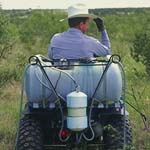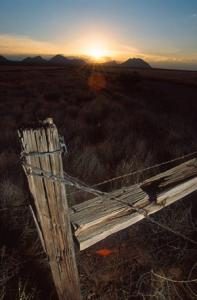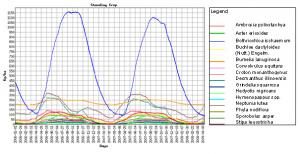
PestMan
A free, web-based decision support system that assists rangeland managers in making economically beneficial brush and weed management decisions in Texas and New Mexico
Brush and weed management decisions for Texas and New Mexico



PestMan is a free, Web-based decision support system that assists rangeland managers in making economically beneficial brush & weed management decisions in Texas & New Mexico. PestMan not only provides a comprehensive list of chemical and mechanical treatments for the most common problem plants in each state, but it also allows the user to examine the long-term financial gains or losses of these treatments in light of their own situation. PestMan takes the work out of deciding whether or not a brush or weed management option will increase profits from increased forage!
PestMan was developed from two previously existing programs by the Center for Natural Resource Information Technology (CNRIT) at Texas A&M University using expert recommendations for chemical and mechanical treatments. It is funded in part by the USDA Risk Management Agency and USDA NRCS. PestMan was developed by a team that included Texas AgriLife Research and Extension, New Mexico State University, Grazingland Management Systems (GMS), and Ag Force.
A holistic decision support system for pest management
Pests affect an estimated 76% or 728 million acres of land area in the western portion of the United States. Control and management of noxious invasive brush and weed pest species continue to diminish the sustainability of our rangelands and other forage producing lands.
High costs associated with investment in many of the brush and weed control practices/programs, together with the high degree of uncertainty, forage producers face tough choices when confronted with brush/weed control decisions. Pestman provides sound pest management options associated with weed and brush control, as well as the economic impact of the options considered. This tool allows managers to analyze the economic and environmental risk associated with controlling pests invading America’s forage lands.
Background information
Prior to the development of PestMan, there was no system available for the grazing land industry that allowed an on-demand, simultaneous selection of both the technically feasible treatment alternatives and the economic risks associated with brush/weed control investment decisions. PestManis the result of combining and expanding two separate programs that have proven successful in recommending pest management products and their efficacy, as well as analyzing the economic impact of brush and weed control. The first, a computer software program called EXSEL (Expert System for Brush and Weed Control Technology Selection), was cooperatively developed by the Texas Agricultural Experiment Station and Texas Cooperative Extension in order to assist technical agency personnel and land managers with brush and weed control decisions. The second is the Grazingland Alternative Analysis Tool (GAAT), which was developed to assist forage and livestock producers in exploring the economic trade-offs of multiple scenarios associated with pest management and livestock grazing alternatives.
Rangeland weed and brush control recommendations provided by PestMan are valid only in Texas. Control recommendations may vary from state to state, even for the same species. Some of the herbicides and/or their uses recommended by PestMan are legal only in regions where they are assigned as valid treatments.
Components of the PestMan decision support system
EXSEL
The EXSEL component of PestMan has been widely used for many years by agency personnel, farm, and ranch supply dealers, private consultants, and producers. The system was designed to provide the best treatment alternatives, application instructions, and guidance on response to expect the following application of brush control treatments. EXSEL is user-friendly, requiring a minimum of data input to accurately support mechanical and chemical brush and weed control decisions. Although the original EXSEL program will be radically revised in the development of PestMan, the essential decision support components will be utilized.
EXSEL prompts users for information essential to appropriate brush and weed control decisions, such as the target plant species, soil texture, target species density, stem diameter and height, and soil moisture status. The program then matches a specific problem with the most technically feasible treatment alternatives.
The program generates reports that contain specific chemical and mechanical treatment recommendations for the target plant species. For chemical treatments, reports include recommended rates of application for each compound as well as additives and specific application instructions. It also provides the expected level of target plant mortality, as well as expected vegetation responses, such as when to expect maximum production increases, how long they will last and when they will return to pre-treatment levels without maintenance practices. Reports also provide comments and caution statements helpful in calling attention to significant features of the treatment or regulations that must be considered.
In addition to the revision of the entire code to facilitate a more efficient database structure, other major enhancements made to the original EXSEL program now embodied in PestMan, include a plant digital image database and text information that will help users properly identify problem target plants and understand the ecology and distribution of the species. The enhancement allows users to indicate if they want to see images of the problem plant and will greatly reduce the possibility of misidentification and misapplication of control technologies. Images can be used to show immature and mature plants and flowering parts important in the selection of control recommendations and chemical rates of application. Another important component of digital imagery will be photographs of the mechanical equipment contained within the recommended control technologies. Available images also include chemical application equipment and even demonstrate appropriate application techniques.
Grazingland alternative analysis tool, GAAT
The second program component included in PESTMAN, the Grazingland Alternative Analysis Tool (GAAT), has been linked with the revised and enhanced EXSEL component to provide an economic analysis tool that is critical to any pest management decision. The GAAT decision support system (DSS) was developed by the Ranching Systems Group at Texas A&M University as part of an integrated set of DSS for and in conjunction with the Natural Resource Conservation Service (NRCS). The program allows the user to test various scenarios; create and edit enterprise budgets; create and edit brush or weed control measures and control programs; and create and edit livestock carrying capacity profiles. The user can create a scenario for a specific situation where a control practice, or set of practices, is planned for a specific location, usually a single management unit (pasture or paddock) of a ranch. Thus, information needed to estimate the economic feasibility must represent the unique conditions and characteristics of the scenario. The basic information required is entered and saved in three categories; enterprise budgets (costs and returns associated with enterprises that will utilize the grazing lands targeted for brush or weed control), control investment profiles (timing and cost of the practice(s) planned for implementation) and carrying capacity profiles (data on the grazing capacity with and without the brush or weed control practice(s) for each year in the planning period). Additional data is entered and saved via the scenario creation/selection screen. All of the information will support the user in making informed economic decisions related to pest management options.
Included in the several reports GAAT provides the user are estimates of the Net Present Value and Internal Rate of Return associated with a specific brush or weed control practice or program. GAAT also provides reports on expected annual revenues, variable costs, and net cash flows both with and without implementation of the control practice(s). Other useful information that GAAT provides the decision maker is the benefit-cost ratio over the specified planning period and the number of years required for the investment in brush or weed control to break even (total added revenue to equal total added costs). With this information, the user is able to better understand and plan for the economic and financial consequences associated with a specific choice of control practice(s).
Other enhancements
Another enhancement contained in PestMan that was not a part of the original EXSEL or GAAT programs is the inclusion of costs of chemical control treatments, both individual plant treatment alternatives and broadcast methods, as well as costs associated with mechanical control practices. Still another enhancement is guidance for users in the selection of response curves that not only provide a temporal scale of post-treatment changes but estimates of the magnitude of changes. These response curves are essential to the economic analyses by identifying the benefits expected from treatment that can then be compared to treatments and associated costs. Response curves will become the link between the two components, technology selection, and economic analysis, of the PestMan program.

